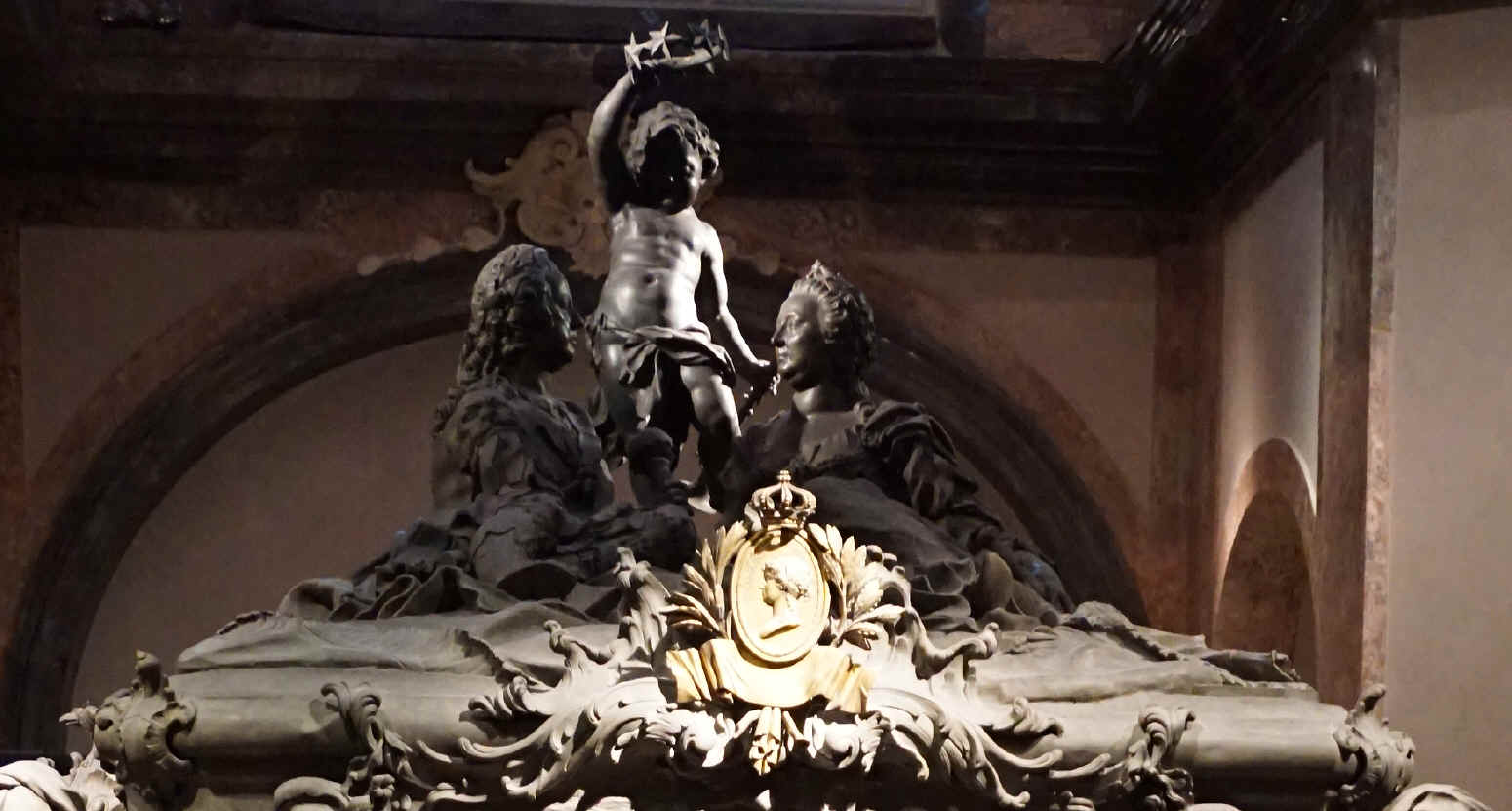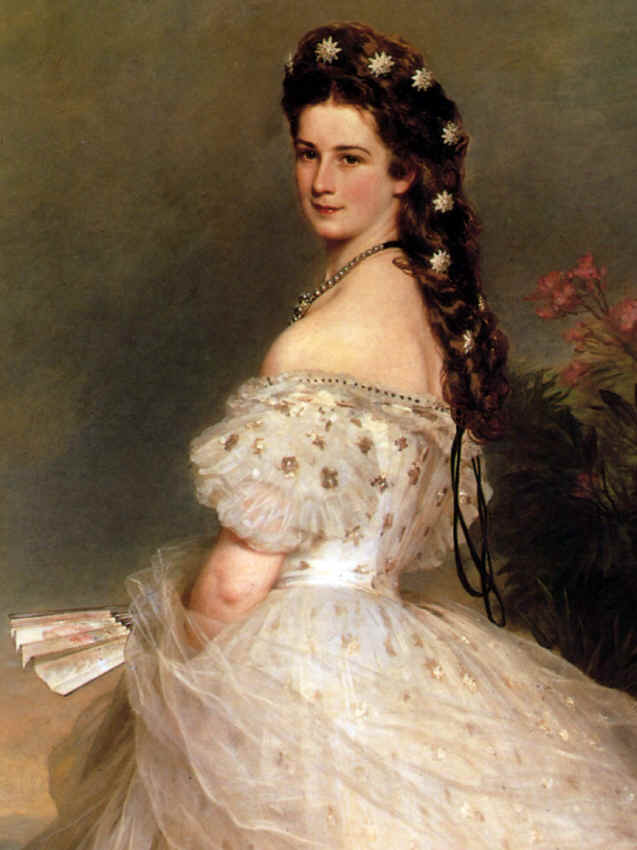The Imperial Crypt
In the oldest part of Vienna, right on the main downtown walking plaza, is the tiny Kapuzinerkirche -- a plain, simple little church that you could walk right past and never notice (I did, several times). But it has been the burial place for the past 500 years of almost all of the Austrian emperors, their wives, and families. The bodies of over 140 of the Habsburg family are lying here, including 12 emperors and 18 empresses. Actually, none of them are "buried" here -- the incredible metal caskets, or sarcophagi, are in full view, as they should be, since most are amazing works of art.
After entering the church, you go underground down a rather plain, modern, industrial-looking set of stairs. You are directed through a set of doors, and suddenly, you are in another world, perhaps another century. Row after row of ornate metal tombs line the walls of the ancient crypt, all carefully polished and labeled. The Habsburgs were perhaps the most royal family in history, producing 645 years of kings, archdukes, and Holy Roman Emperors. The royal family of Spain were also Habsburgs, and one was even the Emperor of Mexico. They tended to marry within their family, since few other families were of high enough rank for them, and also to keep their wealth from getting spread out too far. So cousins married cousins, uncles married nieces, daughters married in-laws, all of which eventually caused so many genetic problems that much of the family was afflicted with bad health, low intelligence, insanity, and deformed faces and bodies. It has been proved that King Carlos II of Spain was so absurdly inbred that his genetic diversity was even less than if his parents had been brother and sister -- they weren't, they were uncle and niece, but all their ancestors were closely related too. All eight of his great-grandparents were descended from the same king and queen. It would have done the family a lot of good to have gotten some strong, healthy peasant blood in their lineage, but they of course were too royal for that, so ironically they become some of the most miserable examples of the human race at the time. However, some were fine people and excellent rulers; many encouraged the arts and sciences of the time. The glory of Vienna to this day is the result of all those centuries of Habsburg rule.
After an elaborate
funeral, when a royal body was brought to the Imperial Crypt, the funeral procession
would stop at the front door of the church and the priest would knock on the
door three times. From
within, a voice of a monk would ask, "Who is requesting entry?"
The priest would read off the full name and royal titles of the person, such as
this actual official title of Emperor Charles VI:
"Charles Francis
Josephus Wenceslaus Balthazar Johannes Antonius Ignatius, by the
grace of God elected Holy Roman Emperor of Austria, forever King in Germany, of
Castile, Aragon, Leon, Sicily, Jerusalem, Hungary, Bohemia, Dalmatia, Croatia,
Slavonia, Serbia, Galitia, Lodomeria, Cumania, Navarra, Grenada, Toledo,
Valencia, Galicia, Majorca, Sevilla, Sardinia, Cordova, Corsica, Murcia, the
Algarve, Algeciras, Gibraltar, the Canary Islands, the islands of India and the
Ocean sea, Archduke of Austria, Duke of Burgundy, Brabant, Milan, Styria,
Carinthia, Carniola, Limburg, Luxemburg, Gelderland, Württemberg, Upper and
Lower Silesia, Calabria, Athens and Neopatria, Prince of Swabia, Catalonia,
Asturia, Margrave of the Holy Roman Empire, of Burgau, Moravia, Upper and Lower
Lusatia, Princely Count of Habsburg, Flanders, Tyrol, Kyburg, Gorizia, Artois,
Landgrave of Alsace, Margrave of Oristano, Count of Goceano, Namur, Roussillon,
Cerdagne, Lord of the Wendish March, Pordenone, Biscay, Molina, Salins, Tripoli
and Mechelen."
The voice from within
would answer, "We know him not!"
The priest outside would knock three times again. Again, the voice within would say,
"Who is requesting entry?"
This time, the priest would answer, "A mortal, sinful human."
And then the door would open, and the body was taken in.
So this charming custom shows that in spite of all their pride and glory, the
Habsburgs realized that even they were not the ultimate power.
This is the first view you have of the royal crypt, built in the
1500's:
Some of the first of the many royal tombs you will see.
The grand tomb of Emperor Charles VI, with the famous crowned
skulls.
A grisly close-up from the above tomb.
These are the oldest sarcophagi in the whole crypt, kept in a
tiny separate room of their own --
Holy Roman Emperor Matthias and his wife
Empress Anna of Tyrol.
The most elaborate tomb of all is that of the Holy Roman Emperor
Francis I, and his wife the Empress Maria Theresa. After he died, she
became the sole ruler, the only woman to ever rule Austria.
A close-up of the end of their tomb, showing a distant battle
scene.
Reclining on the top of their tomb, Francis and Maria Theresa
stare at each other forever.

Francis and Maria Theresa's little
daughter, the Archduchess
Maria Karolina.
Even though Maria Theresa and Francis have the most elaborate
sarcophagus of all, their son Joseph, who became the next Holy Roman Emperor,
decided all that showiness and expense was not proper. He chose to lie in this simple, rustic
casket in front of his parents.
This is Emperor Ferdinand, known for being one of the more mentally
unstable ones. Behind is his wife, Empress Maria Anna of Savoy.
Another little dead princess.
These are the tombs everybody comes to see, even though they are
in a more restrained and sober style compared to the wild baroque extravagance
of the earlier tombs. These are the graves of the most popular and famous
of all the Habsburgs -- Emperor Franz Joseph, his wife, and son. Franz
Joseph was responsible for having all the grand buildings of the Ring Street
constructed during his lifetime. He died in 1916. His casket is the
only one in the crypt made of stone, not metal.
Franz Joseph's wife was the beautiful Empress Elisabeth of
Bavaria -- always known as Queen Sisi. She was assassinated in 1898.
You can see a picture of her at the bottom of this page.
The son of Franz Joseph and Queen Sisi was the Crown Prince
Rudolf, who killed himself along with his girlfriend in 1889. He preferred
death rather than having to become the next emperor. His mother never got
over the shock, and spent the rest of her life travelling the world, spending as
little time as possible at the royal palaces of Vienna.
Here are two of the newest tombs -- on the left is Empress Zita
of Bourbon-Parma, the last empress of them all. On the right is that of
her son, Prince Karl Ludwig, plus a space for his wife, who is still
living. Austria has not had official royalty since WWI, and does not allow
the living Habsburgs to use royal titles; but they still have the right to be
buried in the royal crypt. The most recent tomb is from 2011.
The famous Empress Elisabeth, always called Sisi by the
Austrians.
Her hair was six feet long, and it took her attendants 2 to 3 hours every day to
care for it and fix it up.
She was killed by an anarchist radical in Switzerland with an ice pick to the
heart.

Click here for Page 5 -- the Art History Museum